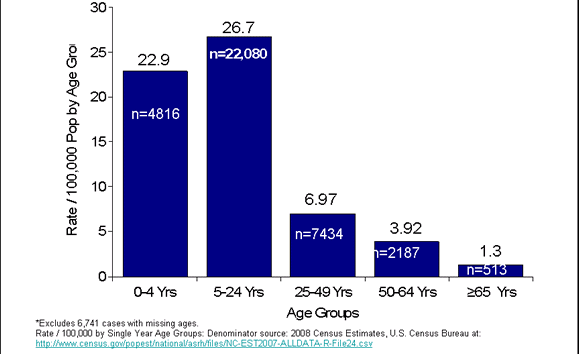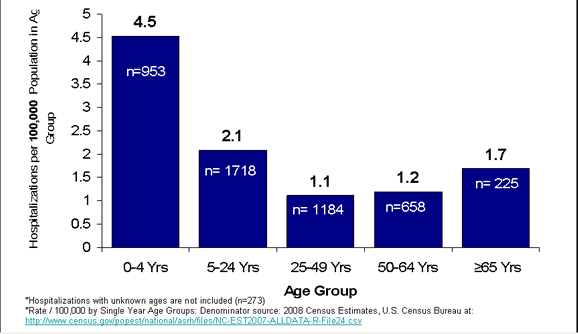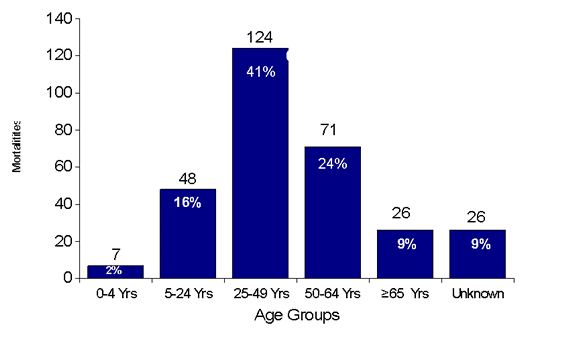Content on this page was developed during the 2009-2010 H1N1 pandemic and has not been updated.
- The H1N1 virus that caused that pandemic is now a regular human flu virus and continues to circulate seasonally worldwide.
- The English language content on this website is being archived for historic and reference purposes only.
- For current, updated information on seasonal flu, including information about H1N1, see the CDC Seasonal Flu website.
2009 H1N1 Early Outbreak and Disease Characteristics
October 27, 2009, 6:00 PM ET
On this Page
- Reported U.S. cases of novel H1N1 flu
- People infected with novel H1N1 flu in U.S.
- Reporting of individual cases
- Secondary attack rate of novel H1N1 virus in household setting
- Generation time of novel H1N1
- Community rates of influenza-like illness associated with novel H1N1 flu outbreak
- Novel H1N1 U.S. cases by age
- Novel H1N1 U.S. hospitalization rate by age
- Underlying medical conditions
- Obesity and novel H1N1
- Symptoms of hospitalized novel H1N1 patients
- Novel H1N1 deaths, by age
Disease Characteristics
When the novel H1N1 flu outbreak was first detected in mid-April 2009, CDC began working with states to collect, compile and analyze information regarding the novel H1N1 outbreak. On July 24, 2009 official reporting of individual cases of confirmed and probable novel H1N1 infection was discontinued. Below is a summary of information gathered during the first weeks of the outbreak. These key disease characteristics are thought to remain an accurate representation of novel H1N1 flu.
How many cases of novel H1N1 flu infection have been reported in the United States?
When the novel H1N1 flu outbreak was first detected in mid-April 2009, CDC began working with states to collect, compile and analyze information regarding the novel H1N1 flu outbreak, including the numbers of confirmed and probable cases of disease. From April 15, 2009 to July 24, 2009, states reported a total of 43,771 confirmed and probable cases of novel influenza A (H1N1) infection. Of these cases reported, 5,011 people were hospitalized and 302 people died. On July 24, 2009, confirmed and probable case counts were discontinued. Aggregate national reports of hospitalizations and deaths will continue at this time.
How many people have been infected with novel H1N1 flu?
A CDC model was developed to try to determine the true number of novel H1N1 flu cases in the United States. The model took the number of cases reported by states and adjusted the figure to account for known sources of underestimation (for example; not all people with novel H1N1 flu seek medical care, and not all people who seek medical care have specimens collected by their health care provider). Using this approach, it is estimated that more than one million people became ill with novel H1N1 flu between April and June 2009 in the United States. The details of this model and the modeling study will be submitted for publication in a peer reviewed journal.
Why did CDC discontinue reporting of individual cases?
Individual case counts were used in the early stages of the outbreak to track the spread of disease. As novel H1N1 flu became more widespread, individual case counts became an increasingly inaccurate representation of the true burden of disease. This is because many people likely became mildly ill with novel H1N1 flu and never sought treatment; many people may have sought and received treatment but were never officially tested or diagnosed; and as the outbreak intensified, in some cases, testing was limited to only hospitalized patients. That means that the official case count represented only a fraction of the true burden of novel H1N1 flu illness in the United States. CDC recognized early in the outbreak that once disease was widespread, it would be more valuable to transition to standard surveillance systems to monitor illness, hospitalizations and deaths. CDC discontinued official reporting of individual cases on July 24, 2009. For more information about how CDC is monitoring novel H1N1 flu, visit “H1N1 Monitoring Q &A”.
What is the secondary attack rate of the novel influenza A (H1N1) virus in the household setting?
The secondary attack rate reflects the risk of someone being infected with a disease by an ill close contact (for example, a family member, classmate or co-worker). Epidemiologic field studies in several states found a secondary attack rate in household contacts for acute-respiratory-illness (ARI) was 18 % to 19% and 8% to 12% for influenza-like-illness (ILI). ARI is defined as two or more of the following four symptoms: fever, cough, sore throat, and rhinorrhea (runny nose). ILI is defined as fever and cough or sore throat. In general, these household secondary attack rates are slightly lower than what occurs in seasonal influenza. The use of antiviral medications (which can reduce viral shedding) to treat cases or prevent influenza in household contacts may have decreased secondary attack rates.
What is the generation time of the novel influenza A (H1N1) virus?
The generation time is the doubling time, or the time required for the number of infections to double in size. Epidemiologic field studies of novel H1N1 flu infections in several states indicate that the generation time for acute respiratory illness (ARI) was 2.0-3.1 days and 2.4-3.1 days for influenza like illness (ILI).
What information is there regarding community rates of influenza-like illness associated with the novel H1N1 flu outbreak?
Community surveys and population-based telephone surveys in areas with focal outbreaks of novel H1N1 flu have reported influenza-like-illness affecting approximately 6% of the population in the areas surveyed. On June 10, 2009, the New York City Health Department released preliminary findings from a household survey suggesting that 6.9% of New Yorkers may have experienced flu-like illness between May 1 and May 20, 2009. The results of these surveys are being submitted for publication in peer reviewed journals.
How have different age groups in the United States been impacted by novel H1N1 flu in terms of infection rates?
When the novel H1N1 outbreak was first detected in mid-April 2009, CDC began working with states to collect, compile and analyze information regarding the novel H1N1 flu outbreak, including the numbers of confirmed and probable cases and the ages of these people. The information analyzed by CDC supports the conclusion that novel H1N1 flu has caused greater disease burden on people younger than 25 years of age than older people.
Graph A (below) shows the estimated rate of novel H1N1 cases per 100,000 people reported to CDC in the United States by age group from April 15 to July 24, 2009. Over this time period, 43,771* probable and confirmed cases of novel H1N1 infection were reported to CDC. The number of reported cases per 100,000 population** was highest among people in the 5 years to 24 years of age group (26.7 per 100,000). This was followed by those in the 0 to 4 years of age group, whose case rate was 22.9 per 100,000 people. The rate declined further to 6.97 people per 100,000 in the 25 years to 49 years of age group. The rate was 3.9 per 100,000 people in the 50 years to 64 years of age group. At 1.3 people per 100,000, the novel H1N1 flu infection rate was lowest in people 65 years and older.
This epidemiological data supports laboratory serology studies that indicate that older people may have pre-existing immunity to the novel H1N1 flu virus. This age distribution is very different from what is normally seen for seasonal flu, where older people are more heavily impacted.
*Of the total number of cases reported to CDC, 6,741cases were omitted from this analysis due to missing ages.
**The denominator in these calculations is derived from national population census data, and is not adjusted for the actual geographic distribution of cases. This thus reflects a national average. Because only a fraction of persons with influenza symptoms are likely to have been tested for novel H1N1, these rate estimates are underestimation of the actual rates. However, the relative difference in rates between age groups is what is most important about these data.
Graph A: Novel H1N1 Confirmed and Probable Case Rate in the United States, By Age Group

How have different age groups been impacted by novel H1N1 flu in terms of hospitalization rates in the United States?
When the novel H1N1 flu outbreak was first detected in mid-April 2009, CDC began working with states to collect, compile and analyze information regarding the novel H1N1 flu outbreak, including information on hospitalizations and the ages of people hospitalized with confirmed and probable novel H1N1 flu infection.
Graph B (below) shows the estimated novel H1N1 flu hospitalization rate in the United States by age group from April 15 to July 24, 2009. These estimates are based on the 4,738* hospitalizations that were reported to CDC during this time period. The reported hospitalization rate per 100,000** people was highest among children in the 0 to 4 years of age group. The hospitalization rate of children in the 0 to 4 age group with novel H1N1 flu illness was 4.5 children per 100,000. The next highest reported hospitalization rate was in the 5 to 24 years of age group, which had a hospitalization rate of 2.1 per 100,000 people. The hospitalization rate for people in the 25 to 49 years of age group was lowest at 1.1 per 100,000 people. The hospitalization rate for people 50 to 64 years of age was 1.2 per 100,000 people, and the hospitalization rate for people 65 years and older was 1.7 per 100,000.
While people 65 years and older are much less likely to become ill with novel H1N1 flu, the increase in the hospitalization rate for people in this age groups indicates that if they do become sick, their risk of hospitalization is increased. This is not surprising given that people 65 and older are generally considered at higher risk of serious flu-related complications, including those requiring hospitalization, from seasonal flu illness.
*Of the total population of hospitalizations (n=4,738) 273 cases were omitted from this analysis due to missing ages.
**The denominator in these calculations is derived from national population census data and is not adjusted for the actual geographic distribution of cases. This reflects a national average. Because only a fraction of people with influenza symptoms are likely to have been tested for novel H1N1, these rate estimates are underestimation of the actual rates. However, the relative difference in rates between age groups is what is most important about these data.Graph B: Novel H1N1 U.S. Hospitalization Rate per 100,000 Population, By Age Group

How many patients hospitalized with novel H1N1 flu have had underlying medical conditions?
CDC studied the hospital records of 268 patients hospitalized with novel H1N1 flu early on during the outbreak. The analysis found that the prevalence of selected underlying conditions was significantly higher among hospitalized novel H1N1 flu patients compared to the prevalence in the general U.S. populations, except for chronic renal disease and obesity. For example, asthma occurs in 8% of the U.S. population, but 32% of hospitalized novel H1N1 flu patients had asthma. With seasonal flu, underlying medical conditions like asthma, diabetes, heart disease and pregnancy place people at greater risk of serious flu-related complications.(People may have reported one or more underlying conditions.)
Is obesity considered an underlying medical condition placing people at higher risk of H1N1-related complications?
Obesity is not one of the medical conditions that have previously been recognized to place people at greater risk of serious seasonal flu-related complications; however, obesity has been noted as an underlying medical condition in some hospitalized novel H1N1 patients. In a subset of 268 patients hospitalized with novel H1N1 early on during the outbreak, the body mass index (BMI)* of 227 patients** was calculated. Obesity (defined as a BMI greater than or equal to 30-39.9) was noted in about 15% of these patients and morbid obesity (defined as BMI greater than or equal to 40) was noted in about 8% of these patients. Although the importance of obesity as a contributing factor to novel H1N1 complications is currently unknown, many obese persons have other known underlying diseases that put them at risk for flu complications.
More information about novel H1N1 and obesity is available in a July 10, 2009 Morbity and Mortality Weekly Report (MMWR) Dispatch entitled “Intensive-Care Patients With Severe Novel Influenza A (H1N1) Virus Infection --- Michigan, June 2009.” A striking prevalence of obesity in the intensive care patients evaluated in this report was noted.
*Body mass index (BMI) is a measure of body fat based on height and weight.
**BMI was not calculated for pregnant women and children younger than 2 years in this subset of 268 hospitalized patients.
What symptoms did hospitalized patients have?
The symptoms of novel H1N1 flu virus in people are similar to the symptoms of seasonal flu, although vomiting and diarrhea has been reported more commonly with H1N1 flu infection than is typical for seasonal flu. CDC studied the hospital records of 268 patients hospitalized with novel H1N1 flu early on during the outbreak. In this early subset of cases with significant clinical data, fever (93%) and cough (83%) were the two most reported symptoms. This is not surprising since cough and fever were part of the case definition. Other symptoms were shortness of breath (54%), fatigue/weakness (40%), chills (37%) and myalgias (muscle soreness) (36%). (See Table below) Severe illnesses and death has occurred as a result of illness associated with this virus.
Symptom |
Number (%) |
|---|---|
| Fever* | 249 (93%) |
| Cough | 223 (83%) |
| Shortness of breath | 145 (54%) |
| Fatigue/Weakness | 108 (40%) |
| Chills | 99 (37%) |
| Myalgias | 96 (36%) |
| Rhinorrhea | 96 (36%) |
| Sore Throat | 84 (31%) |
| Headache | 83 (31%) |
| Vomiting | 78 (29%) |
| Wheezing | 64 (24%) |
| Diarrhea | 64 (24%) |
How have different age groups been affected by novel H1N1 flu in terms of deaths?
CDC studied the hospital records of 268 patients hospitalized with novel H1N1 flu early on during the outbreak. The number of deaths was highest among people 25 to 49 years of age (39%), followed by people 50 to 64 year of age (25%) and people 5 to 24 year of age (16%) This is a very different pattern from what is seen in seasonal influenza, where an estimated 90% of influenza-related deaths occur in people 65 years of age and older. (See Graph C below)
Graph C: Novel H1N1 U.S. Deaths, By Age Group

Get email updates
To receive weekly email updates about this site, enter your email address:
Contact Us:
- Centers for Disease Control and Prevention
1600 Clifton Rd
Atlanta, GA 30333 - 800-CDC-INFO
(800-232-4636)
TTY: (888) 232-6348 - Contact CDC-INFO


